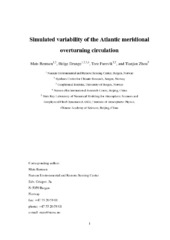Simulated variability of the Atlantic meridional overturning circulation
Journal article
Submitted version

Åpne
Permanent lenke
https://hdl.handle.net/1956/630Utgivelsesdato
2004-04-17Metadata
Vis full innførselSamlinger
- Geophysical Institute [1186]
Originalversjon
Climate Dynamics. 2004, 22 (6/7): 701-720. https://doi.org/10.1007/s00382-004-0397-xSammendrag
To examine the multi-annual to decadal scale variability of the Atlantic Meridional Overturning Circulation (AMOC), a four-member ensemble with a daily reanalysis forced, medium-resolution global version of the isopycnic coordinate ocean model MICOM, and a 300-years integration with the fully coupled Bergen Climate Model (BCM), have been conducted. The simulations of the AMOC with both model systems yield a long-term mean value of 18 Sv and decadal variability with an amplitude of 1–3 Sv. The power spectrum of the inter-annual to decadal scale variability of the AMOC in BCM generally follows the theoretical red noise spectrum, with indications of increased power near the 20-years period. Comparison with observational proxy indices for the AMOC, e.g. the thickness of the Labrador Sea Water, the strength of the baroclinic gyre circulation in the North Atlantic Ocean, and the surface temperature anomalies along the mean path of the Gulf Stream, shows similar trends and phasing of the variability, indicating that the simulated AMOC variability is robust and real. Mixing indices have been constructed for the Labrador, the Irminger and the Greenland-Iceland-Norwegian (GIN) Seas. While convective mixing in the Labrador and the GIN Seas are in opposite phase, and linked to the NAO as observations suggest, the convective mixing in the Irminger Sea is in phase with or leads the Labrador Sea. Newly formed deep water is seen as a slow, anomalous cold and fresh, plume flowing southward along the western continental slope of the Atlantic Ocean, with a return flow of warm and saline water in the surface. In addition, fasttravelling topographically-trapped waves propagate southward along the continental slope towards equator, where they go east and continue along the eastern rim of the Atlantic. For both types of experiments, the Northern Hemisphere sea level pressure and 2 m temperature anomaly patterns computed based on the difference between climate states with strong and weak AMOC yields a NAO-like pattern with intensified Icelandic low and Azores high, and a warming of 0.25–0.5°C of the central North Atlantic sea surface temperature (SST). The reanalysis forced simulations indicate a coupling between the Labrador Sea Water production rate and an equatorial Atlantic SST index in accordance with observations. This coupling is not identified in the coupled simulation.